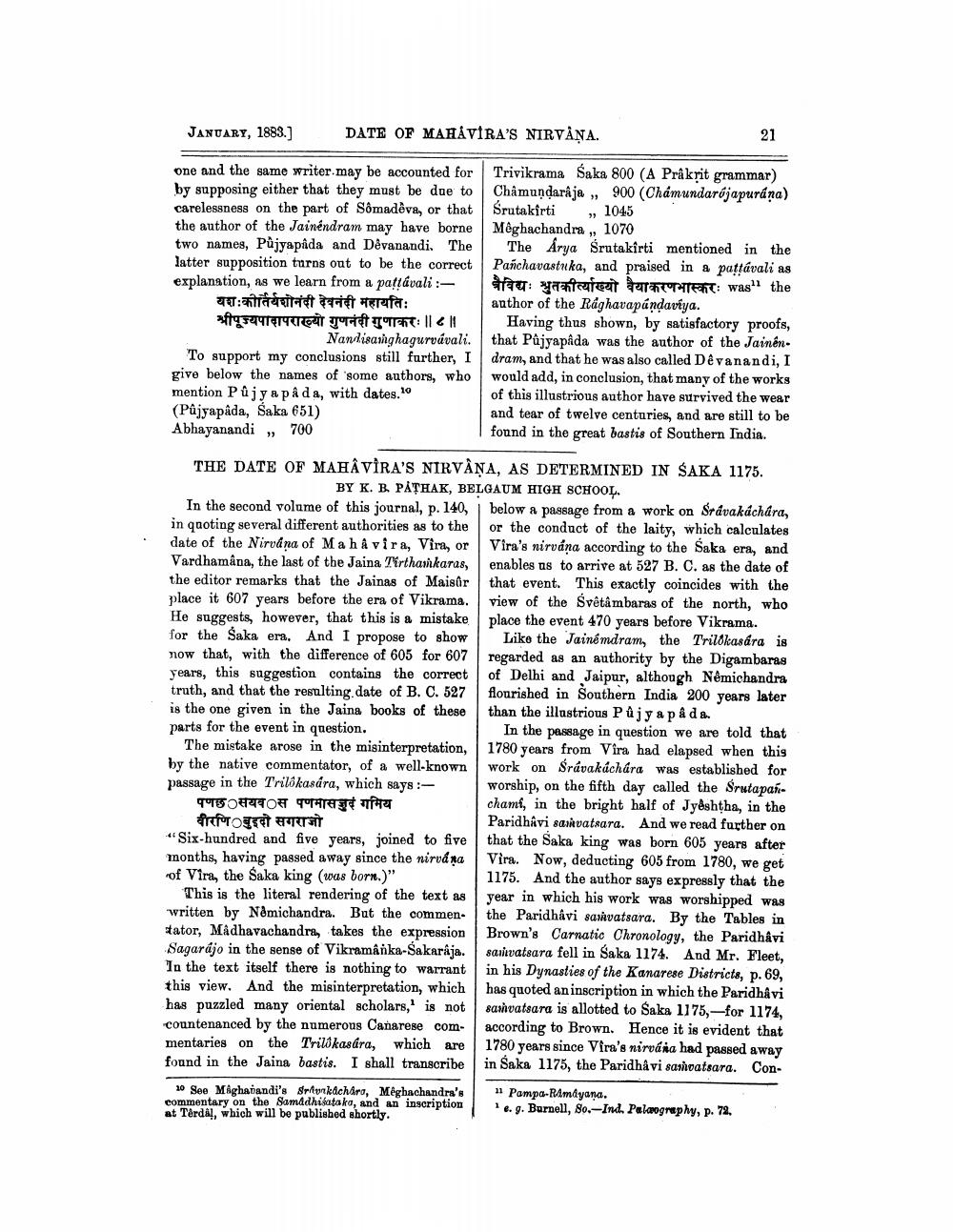________________
DATE OF MAHAVIRA'S NIRVANA.
JANUARY, 1883.]
one and the same writer may be accounted for by supposing either that they must be due to carelessness on the part of Somadeva, or that the author of the Jainéndram may have borne two names, Pujyapâda and Dêvanandi. The latter supposition turns out to be the correct explanation, as we learn from a paṭṭávali :
यश: कीर्तिर्यशोनंदी देवनंदी महायतिः
श्री पूज्यपादापराख्यो गुणनंदी गुणाकरः ॥ ८ ॥ Nandisaighagurvávali.
To support my conclusions still further, I give below the names of some authors, who mention Pujya på da, with dates. 10 (Pujyapada, Śaka 651) Abhayanandi.. 700
In the second volume of this journal, p. 140, in quoting several different authorities as to the date of the Nirvana of Mahavira, Vira, or Vardhamâna, the last of the Jaina Tirthankaras, the editor remarks that the Jainas of Maisûr place it 607 years before the era of Vikrama. He suggests, however, that this is a mistake for the Šaka era. And I propose to show now that, with the difference of 605 for 607 years, this suggestion contains the correct truth, and that the resulting date of B. C. 527 is the one given in the Jaina books of these parts for the event in question.
The mistake arose in the misinterpretation, by the native commentator, of a well-known passage in the Trilokasára, which says:छवस पणमासजुदं गमिय वीरणिबुदी सगराजो
"Six-hundred and five years, joined to five months, having passed away since the nirvana of Vira, the Saka king (was born.)"
This is the literal rendering of the text as written by Nêmichandra. But the commentator, Madhavachandra, takes the expression Sagarajo in the sense of Vikramânka-Šakaraja. In the text itself there is nothing to warrant this view. And the misinterpretation, which has puzzled many oriental scholars,' is not countenanced by the numerous Canarese commentaries on the Trilokasára, which are found in the Jaina bastis. I shall transcribe
THE DATE OF MAHAVIRA'S NIRVANA, AS DETERMINED IN SAKA 1175.
BY K. B. PATHAK, BELGAUM HIGH SCHOOL.
10 See Maghavandi's Srunkacharo, Méghachandra's commentary on the Samadhisatako, and an inscription at Têrdal, which will be published shortly.
21
Trivikrama Šaka 800 (A Prâkrit grammar) Châmundarâja,, 900 (Chámundaréjapurana) Śrutakîrti " 1045 Mêghachandra,, 1070
The Arya Śrutakîrti mentioned in the Panchavastuka, and praised in a paṭṭávali as त्रैविद्यः श्रुतकीर्त्याख्यो वैयाकरणभास्करः was the author of the Raghavapáṇḍaviya.
Having thus shown, by satisfactory proofs, that Pujyapâda was the author of the Jainên dram, and that he was also called Dê vanandi, I would add, in conclusion, that many of the works of this illustrious author have survived the wear and tear of twelve centuries, and are still to be found in the great bastis of Southern India.
below a passage from a work on Śrávakáchára, or the conduct of the laity, which calculates Vira's nirvana according to the Saka era, and enables us to arrive at 527 B. C. as the date of that event. This exactly coincides with the view of the Svêtâmbaras of the north, who place the event 470 years before Vikrama.
Like the Jainémdram, the Trilokasára is regarded as an authority by the Digambaras of Delhi and Jaipur, although Nêmichandra flourished in Southern India 200 years later than the illustrious Pujya pada.
In the passage in question we are told that 1780 years from Vira had elapsed when this work on Śrávakáchára was established for worship, on the fifth day called the Srutapanchami, in the bright half of Jyeshtha, in the Paridhavi samvatsara. And we read further on that the Saka king was born 605 years after Vira. Now, deducting 605 from 1780, we get 1175. And the author says expressly that the year in which his work was worshipped was the Paridhâvi samvatsara. By the Tables in Brown's Carnatic Chronology, the Paridhâvi samvatsara fell in Saka 1174. And Mr. Fleet, in his Dynasties of the Kanarese Districts, p. 69, has quoted an inscription in which the Paridhâvi samvatsara is allotted to Saka 1175,-for 1174, according to Brown. Hence it is evident that 1780 years since Vira's nirvana had passed away in Saka 1175, the Paridhâvi samvatsara. Con
11 Pampa-Ramayana.
e. g. Burnell, So.-Ind. Palaography, p. 72,




